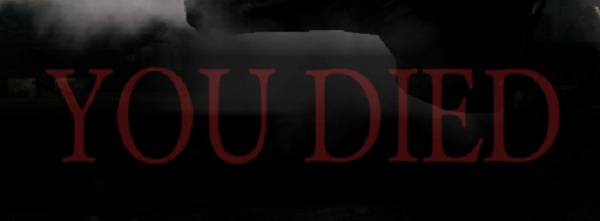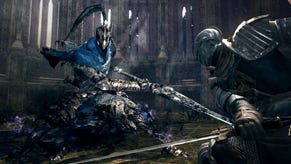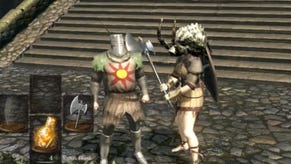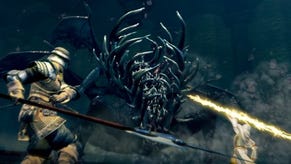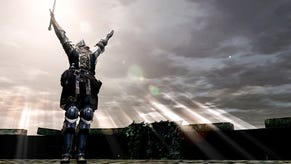Wot I Think: Dark Souls - Prepare To Die Edition
The preparations, they do nothing
Demanded and then reprimanded, Dark Souls: Prepare To Die Edition is the most basic port of one of the most peculiar and powerful games of recent times. It's unforgiving, mysterious, bizarre and thoroughly rewarding, but are there enough graphics to let the brilliance shine through and does the game deserve its reputation? Here’s wot I think.
Dark Souls is Groundhog Day but in the ruins of a fantasy realm rather than the weather-blighted Punxsutawney. Or maybe it’s an exercise in self-abuse and language lessons, the eventual player commentary an inventive catalogue of insults and blasphemy. I reckon it’s both of those things but it’s also Zelda in Hell, and to a far greater extent than Darksiders is, despite that game actually pretty much being Zelda in Hell. Souls doesn't borrow mechanics, it borrows a philosophy.
The original Legend of Zelda, so it goes, was Shigeru Miyamoto’s attempt to capture the childhood wonder of exploring the woods and caves around Kyoto, to place that sense of adventure and awe in the home of anyone with the necessary hardware. As the next screen flipped into view, new possibilities slid into being, some revealing themselves instantly, others concealed and requiring determination, guile and an item from the other side of the sodding map to uncover.
If Miyamoto had grown up afraid of the forests and caves rather than intrigued by them, he’d probably have made something like Dark Souls and sent us all straight from Lode Runner to Lordran rather than to the brighter climes of Hyrule. Perhaps there’s already a Demon's Souls demake that imagines just such an alternate history of gaming, and if not somebody really should make it so. That said, the Souls games do have a pedigree of their own and if you’re left wanting more after battling through the gruelling nightmares of Dark Souls, the prequel is more of the same (and also not at all essential to understanding or enjoyment of the second). Then there are the King’s Field games, From’s first foray into the kind of dark fantasy that should have made them much more widely known back in the ‘90s.
I can only assume we were all too busy forming very important opinions about Blur and Blair to bother making petitions demanding a PC release of King’s Field back in the Britpop days, although this fan translation of a PC remake could be worth a look. Haven’t tried it myself because I’ve been too busy playing Dark Souls during almost every waking moment. And, yes, I do want more, and that’s having already played both Demons and Dark on PS3 before carving my way through the Prepare to Die Edition over the last five days. I’ve killed the same elastic-boned undead torchbearers what seems like a million times, my journeys through the bristling bleakness now artfully perfected, but I’m not done yet because there’s more soul-searching to do and, from the start, it could all have been so different.
When you die in Dark Souls, whether it’s the first time or the thousandth time, your carcass awakes at the last bonfire that you rested at. These tiny beacons are the one-stop shop for all the business of healing and soul-spending, although there are merchants dotted around the world as well for your actual shopping needs. They’re usually either trapped or insane, which is pretty much a requirement for setting up a stall in the midst of this much bleakness and horror.
Back to the bonfires though, which you will learn to love and to curse, overjoyed when catching sight of one in the distance for the first time and sick of the sight by the billionth time you have spawned at it. Not only can you spend your hard-earned souls at a bonfire, which prevents them from being lost the next time you die, you also heal when you rest and you also refill your Estus flask, which is the only health potion in the wide damned world. Unfortunately, every minor monster in the world also heals when you rest. It’s the ultimate balance of risk and reward. Gathering lost souls from your own corpse is also possible, although dying a second time before retrieval causes them to be lost for good. So, best not die near a massive dangerous monster then, eh?
While at a bonfire, you can also spend humanity to revert from the undead state in which you begin the game but more on that later. Being a shambling, hollow corpse isn’t a problem that needs to be resolved immediately. The first thing to do is to escape from an asylum, take a trip in the claws of a bird and decide whether to die in a graveyard, a burning village or a haunted lake. That, after choosing your class, is the first real decision Dark Souls allows you to make.
Dark Souls resembles an RPG, with its levels, stats and classes, but that’s only one aspect of the game. Killing monsters and collecting souls is kind of like gathering experience, sure, and it’s certainly possible to grind, min-max and become the best possible version of whatever it is you want to be, whether agile assassin, armoured knight, archer, cleric or wizard. Thanks to the multiplayer sharing of the world I’ve seen phantom images of other players who are as unlike my character as another humanoid could be. One lonely figure, clinging to the solace of a bonfire’s glow, was the spitting image of Rincewind, pointy hat and all.
Ghosts are everywhere, the images of other players passing by as they explore a world that is perhaps parallel to the one you occupy. Bask in the warmth of a bonfire and other wanderers fade in and out of view as you save your souls by the light of the same flame. There are ways to invade those parallel worlds or to call their inhabitants to your aid but this costs humanity rather than souls, the game’s other major resource. Humanity restores your hollow corpse to its living glory, allowing multiplayer interactions and other things besides. The joy of discovering features, places and creatures is strong so there shan’t be too many specifics here. That's not to say the multiplayer component isn't worthy of consideration; it's superb, populating an already haunted world with phantoms and memories, and providing an eventual gateway by which to become an all-but anonymous hero or villain.
Instead of details, it’s story time. Here are two standout moments that should help to explain how the game deals with death and difficulty, and also how varied and exquisite combat can be. The first story tells the simplest of all Dark Souls’ tales. I call it ‘The fucking bastard knight thing bastard that killed me and killed me and then killed me again’.
It starts at the bottom of a watchtower, although it could start anywhere really, anywhere claustrophobic, contained and home to a fucking bastard knight thing bastard. I, playing the part of spear-wielding warrior-rogue Majolica, enter through a door and the fucking bastard knight thing bastard hits me with a chunk of metal so large and heavy that he rocks backwards as he raises it above his head. It flattens me and I am dead.
Even as the screen fades, the words ‘YOU DIED’ barely registering, a mere comma in the activity of my last few days, I notice that the thing he hit me with doesn’t resemble any sort of weapon I can think of. It’s like a man-sized cudgel if anything. I come to the conclusion that Havel, for that is his actual name, hasn’t even bothered fashioning the hunk of titanite or unobtainium or whatever the heck it is he’s carting around, into a recognisable shape because he quite simply doesn’t give a single shit about how it looks. He just wants to be able to flatten people with it. People like me.
As the next half hour taught me, the cudgel-lump is extremely effective and Havel, ponderous as it makes him, is a difficult man to kill. Or at least Majolica and me found him to be a significant obstacle but a magic user or an armour-plated, double-handed axe-waving maniac might have found him much easier. The most traumatic hour of my life to date was spent fighting a giant butterfly. If I’d been able to lob magical death at the glittering monstrosopillar I’d probably have been done in five minutes.
Here’s how combat works. You look at the thing you have to kill, whether it’s an enormous and terrifying abomination or a fat man with a lump of metal, and then you look at yourself. Then you die, look at yourself again, try to work out how you can dodge, block or neutralise the enemy attack using your own equipment and talents, and how you can strike back. Then you die because there’s never just one or two patterns to learn and you rolled into a wall when trying to dodge, or fell off a cliff while circling, ready for the kill. So you look at the environment, you look at the enemy and you look at yourself, and you try to work out a way to combine all of those things effectively.
Then you die but you realise that you’ve found a technique that might just work provided you can perform it effectively, dodging and thrusting, for five minutes without making a single mistake. Then you die so often that you think your patience will run out but you keep sprinting back from the closest bonfire, killing every enemy on the path without hesitating or thinking, because it seems like you’re making progress, closer to the kill each time. And then you die because that lack of thought and hesitation means that one of the respawned simpletons between the bonfire and the true enemy slips a lucky (you tell yourself ‘lucky’ but there’s no luck here) blade into your gut and you’re overconfident and nonchalant, and that’s a surefire way to die.
So it goes. You die and you die, then you die and in between that you die again. But eventually you win and what happens? Does Havel explode, spewing loot and coins everywhere in jolly little piles? Does he tell you where to go next as he coughs up blood and cliches in an agonisingly drawn-out cutscene in which you learn that his metal banana was forged in the keenest flames of the darkest pit? Not bloody likely.
There might be some glowing stuff on the ground and reading the descriptions of how Havel’s gear worked might give you a clue as to who he was but there’s no explanation, no exposition and no celebration. Well, as far as the latter is concerned, there’s no celebration onscreen but I punched the air so hard I shattered its jaw. Sorry, the air, but that’s how good it feels when a game’s reward is a better understanding of its systems and the character I have built.
It is necessary to level up and find new gear but Dark Souls is never so crude as to tell you that you’ve improved to a suitable degree and hand over a key to a more dangerous area. Instead it challenges you to improve yourself and lets you go wherever you reckon your fragile little body can survive, and if you’ve found the route or the correct key then you’re welcome to all the horrors that each grim corner of the world has to offer.
My second story took place in one of those grim corners; The Depths, an actually acceptable sewer-type area of the oddly vertical urban sprawl that exists at one edge of the mausoleum that is the game’s world. Down there are basilisks, all rubbery skin and goggling eyes. They swarmed me and they turned me into a horribly serrated statue. Still I awoke, back at a bonfire down in those depths, and I was cursed, my maximum health halved until a cure was purchased. Too weak to recover the souls that clung to my corpse, I instead travelled up, fighting and failing, trying to reach the surface where I knew a cure could be found.
I was trapped for hours, too afraid to go deeper, too weak to ascend. It’s the closest I’ve come to feeling completely lost and doomed to eternal death in a game for a long, long time. Curses, like so many boosts and buffs, do not immediately explain themselves and nor is a solution or purpose directly communicated. Experimentation and exploration are the key to discovery and victory.
For all the game’s complexity, if you understand that it is better to dodge an attack rather than be struck by it, and that heavier armour and weapons will make leaping and dodging more difficult, then you will make progress, slow but sure. As for the more complex systems at work, they make sense in time and the weirdness of the game always seems an intentional part of the murky lens through which it is viewed rather than evidence of poor documentation. It dares the player to explore and to learn and it will more quickly bite off his/her hand than hold it. That feels liberating. You're in a fight from the start, not a dance, and that means it's OK to hit back however you can. Once the tutorial is complete (and even that will probably kill you) the world is open and there are no warnings and no signposts. Go, see, suffer.
There is lore and history to Lordran, although the game can feel entirely plotless if you don’t intentionally search for and piece together the scraps of information. Is the entire world in the same state as me, dying and trying, then dying again? Hollowed out and withered of face, I seek out ruined watchtowers, sunken cities and a snow-kissed painted world, which makes for a particularly strange excursion even in the confusing context that has come before. The few talkative inhabitants of this weird landscape have referred to me, variously, as a saviour, as dead and as doomed, but none of them seem particularly keen on telling me where to go or what to do. That excites me. Without guidance, in a dangerous and alien world, mistakes are inevitable and they will not go unpunished. That frightens me.
Aroused and afraid, I’ve rarely been happier.
The whole thing runs smoother than on console, where there was terrible and consistent slowdown in certain areas. Blightown, the worst offender on PS3, was fine for me, although heavy use of particle effects, particularly during a waterlogged fight, did cause a framerate drop. The extra content isn’t necessarily as expansive as Namco claim, although that will vary from player to player, but it’s up to the same standard as the rest of the game rather than feeling as rushed as the journey to PC.
Of course I wish the port was strong rather than perfunctory, in fact I wish the game had been developed on PC from the start, but with the current speed of customer-built fixes hopefully there’s more to come. I played with a 360 controller, which works as well as expected, but the mouse doesn’t seem particularly well implemented, the view swinging somewhat sluggishly and the cursor always managing to litter the screen for no good reason. And, yes, Games For Windows Live is an interruption I find hard to ignore, particularly since it took me two or three hours to break through its barriers when I first installed the game.
All has been fine since then but I’d much rather a game this good didn’t have to come with any excuses or apologies. The fact that it does is frustrating but doesn’t alter the fact that this is, even on a second appraisal, one of the freshest and most astonishing games I’ve ever had the pleasure to encounter.
Oh, piss.
Dark Souls: Prepare To Die Edition is available now.





